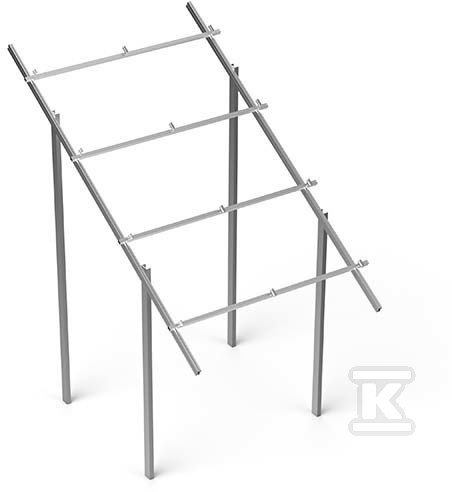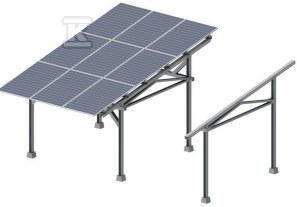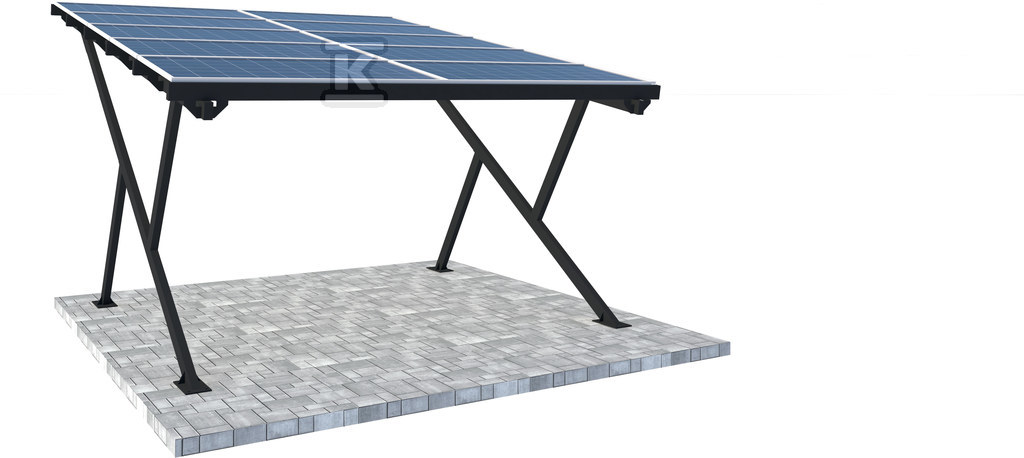Photovoltaic installation is becoming increasingly popular due to the increasing efficiency and durability of the systems and attractive and easily accessible forms of financing. One of the basic decisions that awaits the investor concerns the location of the photovoltaic panels. The choice made will determine the use of sunlight and, consequently, the energy efficiency of the PV installation. Photovoltaic panels can be located on both a flat roof and a sloping roof. We check whether it is more profitable to install photovoltaics on a flat or sloping roof, or perhaps on the ground.

Check out the PV ground structures at the Onninen wholesaler
How does the arrangement of photovoltaic panels affect energy efficiency?
The location of the PV panels and their angle of inclination are factors that affect the efficiency of the entire system, so it is worth entrusting the selection of the location and assembly work to specialists. Photovoltaic installations are most often installed on the roofs of buildings, slightly less often on the ground. Installing photovoltaic panels on the roof is a better solution when the plot area is limited.
 It is also a more discreet and visually appealing option. In addition, a photovoltaic installation on a roof, which in Poland traditionally faces south, provides optimal exposure of the panels to sunlight, which, combined with a tilt angle of 30-40o (or lower for safety reasons), translates into more efficient energy production. There is a small risk that even tall trees will cause shading. However, not every roof is suitable for the installation of photovoltaics.
It is also a more discreet and visually appealing option. In addition, a photovoltaic installation on a roof, which in Poland traditionally faces south, provides optimal exposure of the panels to sunlight, which, combined with a tilt angle of 30-40o (or lower for safety reasons), translates into more efficient energy production. There is a small risk that even tall trees will cause shading. However, not every roof is suitable for the installation of photovoltaics.
It must be suitably strong, because the mounting structures for PV installations together with the panels constitute an additional, considerable load. Greater benefits are usually achieved with a south-facing sloping roof. But photovoltaics on a flat roof also makes sense! However, it may require the use of higher-power panels and the preparation of special support structures that will allow the full use of the potential of the flat surface. And this increases the cost of the investment.
On the other hand, an individually created solution often turns out to be more effective than a ready-made photovoltaic set mounted on a pitched roof. PV installations on flat roofs are perfect for large surfaces. They can often be seen on office buildings, warehouses, manufacturing plants, shopping malls, etc.
Are ground-mounted panels a good idea?
 When roof mounting is not an option for some reason, and the area is large enough and adequately sunny – without trees and buildings causing shade, photovoltaics can be installed on the ground. For this purpose, special, solid ground structures for PV are used. The need to make an excavation may be an inconvenience for the investor. On the other hand, more effective cell ventilation is provided on the ground than on the roof, which promotes high installation efficiency.
When roof mounting is not an option for some reason, and the area is large enough and adequately sunny – without trees and buildings causing shade, photovoltaics can be installed on the ground. For this purpose, special, solid ground structures for PV are used. The need to make an excavation may be an inconvenience for the investor. On the other hand, more effective cell ventilation is provided on the ground than on the roof, which promotes high installation efficiency.
In addition, ground-mounted PV panels can be easily positioned to maximize sun exposure. The angle of inclination is always 35 degrees. In the winter season, especially in mountainous towns, investors particularly appreciate the ease of shedding snow from the panels. In addition, ground-mounted photovoltaics are definitely easier to expand (of course, provided that you have a sufficiently large area). As a rule, ground-mounted photovoltaics are more expensive to implement than sloping roof photovoltaics.
Building permits and photovoltaic panels on pitched roofs, flat roofs and on the ground
Most of the PV installations implemented for the needs of households and small businesses are so-called micro-installations. Their power does not exceed 50 kW. According to the law, they do not require a building permit - regardless of whether the investor intends to install photovoltaic panels on the ground or on a sloping/flat roof.
 All you need to do is report it to the power plant. There are a few exceptions to this rule, such as installing photovoltaic panels at a height of over 3 meters (e.g. on an industrial building or a telecommunications mast) and in areas covered by the Natura 2000 program. More formalities also await investors planning to install photovoltaics on a building that is listed in the register of historic monuments. Recently, the procedures for PV installations with a capacity of up to 150 kWp have been relaxed. In their case, you do not need to apply for a building permit, but you must comply with the so-called connection conditions. Private investors rarely struggle with legal procedures on their own. Companies installing photovoltaics generally provide comprehensive services, including handling formalities.
All you need to do is report it to the power plant. There are a few exceptions to this rule, such as installing photovoltaic panels at a height of over 3 meters (e.g. on an industrial building or a telecommunications mast) and in areas covered by the Natura 2000 program. More formalities also await investors planning to install photovoltaics on a building that is listed in the register of historic monuments. Recently, the procedures for PV installations with a capacity of up to 150 kWp have been relaxed. In their case, you do not need to apply for a building permit, but you must comply with the so-called connection conditions. Private investors rarely struggle with legal procedures on their own. Companies installing photovoltaics generally provide comprehensive services, including handling formalities.
We encourage suppliers and installers of photovoltaics to familiarize themselves with the offer of our wholesaler. Our assortment includes, among others, ready-made photovoltaic sets, photovoltaic panels, inverters and mounting structures. You will find PV structures for a pitched roof , PV structures for a flat roof and PV structures for the ground. Onninen's technical and sales specialists answer questions and advise on individual solutions.
Check out the PV ground structures at the Onninen wholesaler